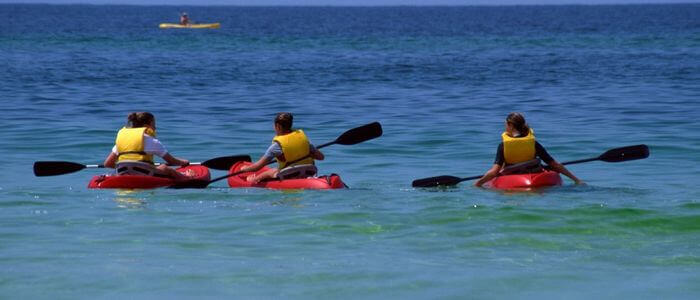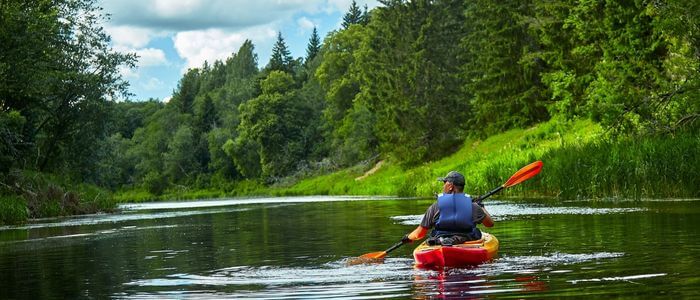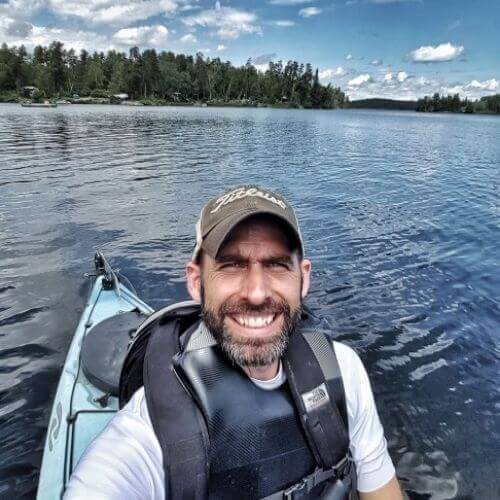
Kayaking is a dynamic water sport that is a fun way to spend time with family and friends while discovering nature. It’s a great way to peacefully explore the open water at the edge of a shore. Kayaking is available to everyone and doesn’t require special skills or training. All you need is some basic knowledge about kayaking.
This article will provide you with basic kayak beginner tips that will help you start a kayaking adventure even if you’ve never kayaked before!

First of all, try to choose locations with a lot of landing areas. If something goes wrong, you will be close to several locations where you may land. You can swim to those places and get yourself out of the water. Please select a location where it is easy to get started. For example, a nice sandy beach with a gentle slope that isn’t crowded with expensive bass boats.
You can also choose a small lake or pond where the water is calm and where you can see the other side. The waters that don’t have a lot of powerboat traffic are better because there won’t be as many waves.
As a beginner, you should avoid the following locations:
Beginners shouldn’t start kayaking near coastal beaches because staying on your feet is harder when getting in and out of the kayak. They also increase the chances for you to get hurt and also that your kayak will get hurt. So, the best place for people who have never kayaked before is a nice, warm, sandy beach with a very gentle slope into the water.
There is a direct connection between the weather and the outcome of your kayaking adventure. The best conditions for kayaking are warm, dry weather and calm water. But you should still keep an eye on the forecasts and other quickly changing weather signs. A kayaking trip on the right day can be exciting, but you should not get stuck in bad weather or situations that are too damn difficult for you.
As a beginner, you may want to avoid the following situations:
However, Rain isn’t always a bad thing for a kayaking trip. Rain in the summer can be fun, especially when they bring out living creatures. Usually, kayak trips are only canceled because of bad weather or strong winds. So don’t worry that you’ll have a bad day just because there are black clouds in the sky.
As with boating, surfing, and any other water adventure, kayaking can put a person’s health and safety at risk, particularly if they don’t care to stay safe. However, as these risks are there, you can still have a great time in your kayak. Just be sure to have some basic safety gear.
Headlamp: it is useful if you end up being gone longer than planned.
On a sunny summer day, you may wish to wear shorts that dry quickly and a cool t-shirt. Cotton outfits can be very convenient to wear. You can wear a swimsuit under the clothes, especially since some tours include short dips in the water.
Moreover, when water is everywhere, it’s essential to be careful about hypothermia. So you need to know how hot or cold the water is and dress for it. If the water where you are going for kayaking is below 70 ℉, you must wear a wetsuit.
Sandals are always a good choice for shoes. And don’t forget to wear a hat to protect yourself from the sun. A sun hat or a baseball cap would do. Also, don’t forget to wear UV-protective sunglasses.
First, if you’re a beginner kayaker, you’re likely to get disappointed quickly if you try to use a very sophisticated kayak. If a beginner chooses a kayak made for long-distance trips, it might be hard for them to move around. So, we suggest that people who have never kayaked before start with sit-on-top kayaks for recreational paddling. These kayaks are easy to get in and out of, easy to move around, and great for people just starting.
There are many different types of kayaks, but the sit-on-top kayak is the most famous for several reasons. A sit-on-top kayak has the same shape as other kayaks, but instead of sitting inside the boat, you sit on a shaped depression on the top. They are mostly made of durable, molded plastic and fiberglass. Since these kayaks are made of strong but cheap plastic, they are available at low prices.
Sit-on-top kayaks have extra features that make them more convenient and simple. For example, they have places to keep gear, a rudder, and scupper holes. The tank well, the foot well, and the cockpit all have early-age holes that let water out.
As a beginner, you need to know how to get into a kayak. Getting into a kayak can be challenging, but we’re sure you’ll get the sense of it after a little practice. You can get into a kayak in three ways:
From Deep Water: The most important thing is ensuring your kayak stays stable. Firstly, put one hand on the side of the kayak nearer to you and the other hand on the side that is far from you. Your arm should be stretched across the opening of the seat. Lift yourself until your belly is over the seat of your kayak, and half of your legs will be in the water. Then, turn around so you can fit on the seat. Ensure the kayak is balanced and put your feet in front of you.
When you want to get out of your kayak near the shore:
Getting out from the kayak is simple to remember: do the steps in the opposite order of getting into the kayak.
So, before you paddle, take a moment to learn how to adjust the seat. Understand how to adjust your kayak seat before you get on the water. You can make small changes as you paddle to keep yourself comfortable.
If the seat has a grip around your hips, explore it to see how they help you bend down further or stay in that up position. Some kayak seats with aluminum frames only have two or three fixed positions you can move between. You must recognize how your seat works before you start kayaking.
Correct paddling will make you more efficient and keep your arms from tiring up quickly. So, the correct way of paddling is about holding the paddle, forward stroke, sweep stroke, and reserve stroke.
When you’re holding the paddle, the long edge of the blade should be on top, and the scooped part should face you. Rest the paddle on your head and move your hands until your elbows are just under 90 degrees to get the right-hand spacing. This is a good place to start, and you can vary your hand position throughout the day to work different muscles.
Now get your knuckles in line with the top of the blades and make an O with your thumb and forefinger around the shaft while you’re other fingers rest loosely. Keeping your grip loose will also let your wrist stay straight, which is easier on your joints.
Start by turning your body so that one side faces forward. Then, put the blade in the water near your feet and use your core to move the pasta forward. As you bend, pull back with your bottom hand and push forward with your top hand. When your hand is on your hip, lift the blade out of the water and switch sides.
Remember that most of the work should be done by your core. If you try to paddle with your arms, you’ll get tired fast and have to move your bottom back in your seat. So you should sit up straight to give yourself more power and keep your balance.
The sweep stroke is perfect for making course corrections without losing momentum. Lean forward as far as you’re comfortable, put the blade into the water, and then sweep the paddle in a wide arc around your kayak. Move it to the back of the boat to get a wide turn. It helps to see your pedal to ensure you bring it back as far as possible.
When you want to stop, you should use a reverse stroke. Bend your torso and tuck the blade behind you, then open and pull it forward when it reaches your feet, pull it forward, and switch sides. You can always use the reverse stroke to back up if you get stopped.
Never go into open waters alone. If you know how to kayak, you can do it yourself, but if you bring a friend, you’ll have less room for mistakes. A buddy rescue is faster than a self-rescue; if you’re hurt, you can’t do a self-tow. Moreover, going on an adventure with a partner is more fun.
It’s also hard to imagine, but sometimes you might want to flip your kayak. If you’ve never been kayaking before, it’s probably not going to be easy for you until you’ve completed a few kayaking trips. So, if you try to flip during your initial trips, it could lead to an accident. So, for your initial trips, you shouldn’t flip.
But many experienced kayak paddlers recommend learning how to flip a kayak because it gives you more confidence in the water, especially in difficult situations like the open ocean. The best way to learn how to flip a kayak is with the assistance of a skilled trainer. You can learn two different kinds of spins. One is called a sweep roll, and the other is a vertical roll, also known as a C-to-C roll.
In addition to the kayak and paddle, you should always carry the following:
Kayaking is a fun and adventurous way to spend time on the water. We’ve given you some kayaking tips for beginners that will help anyone who wants to try this water sport to get out and see more of the world.
Even though there is no special training for this sport, these tips can help you greatly. So, we suggest you keep all of these tips in mind before you go kayaking and bring all of the items we’ve listed with you so that you don’t run into any problems and can enjoy your trip.

Hey there kayak lovers! I’m Jay Schwartz, the author here at Kayak Guidance! You know water sports – you know me! My life is all about it. Kayaking, Paddleboarding, Fishing, Snorkeling and so much more. I love to share my passion and knowledge with all of you.

Hey there kayak lovers! I’m Jay Schwartz, the author here at Kayak Guidance! You know water sports – you know me! My life is all about it. Kayaking, Paddleboarding, Fishing, Snorkeling and so much more. I love to share my passion and knowledge with all of you.

Welcome to KayakGuidance.com! If you’re looking to have some fun outdoor water adventures, then you have come to the right place. We help our readers find the best kayaks and water related equipment to help you have the best time of your life whenever you are engaging in water activities.
This site is a participant in the Amazon services LLC associates program, an affiliate advertising program designed to provide a means for sites to earn advertising fees by advertising and linking to Amazon.com.